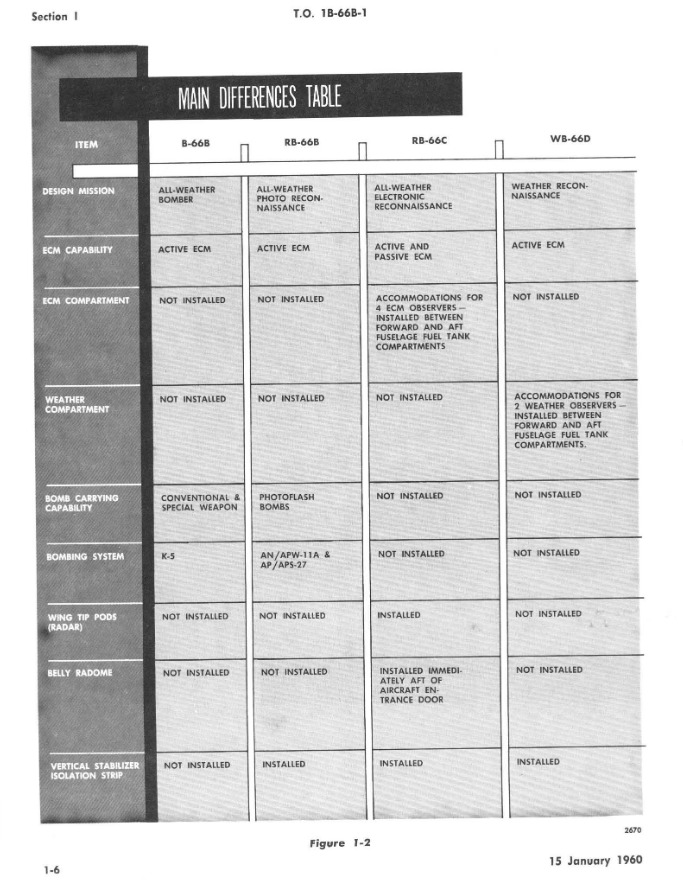- Yes
- No
Introduction: The B-66 is an aircraft which is often forgotten about when discussing Cold War jet bombers. Despite this, the aircraft played and important role in the 1960’s and 70’s, seeing widespread use in Europe, Cuba and Vietnam, though funnily enough, not as a bomber.

Background: In 1951, with the Korean War in full swing, it became clear that the B-26 was rapidly approaching obsolescence. The type was playing a prominent role in the conflict, but was becoming more and more vulnerable to both air and ground fire, suffering high attrition during the conflict. It was noted that a jet-powered replacement was necessary, in order to keep up with the rapidly evolving pace of aerial warfare at the time. A competition was held, with most of the major American aircraft companies putting in designs, with emphasis placed on modifications of pre-existing types, in order to bring the type into service as quickly as possible. Douglas emerged as the winner of the program, with a modified variant of their A3D Skywarrior, which had been chosen by the Navy for their jet bomber program some time before.

Description: Although outwardly similar to the A3D, the B-66 was actually quite different. The original intention was for it to be simply denavalised prior to entering service, with some smaller modifications being made in order to make it suitable for USAF use. Due to this, the Airforce decided not to order prototypes, with only a batch of five pre-production RB-66As being ordered, the reconnaissance aircraft was given highest priority. However, as the program continued, more and more was changed, as was requested by the Airforce. This was due to the need to the USAF’s need to operate at low-altitudes, whereas the US Navy had required the A3D to operate at high altitudes. The engines were also changed from the J57 to the J71, due to worries that the production rate for the former would not be able to cope with the order of the B-66. The engine change also required a complete redesign of the internal systems, with the hydraulic pumps and generators being moved to the engines themselves. Apart from this, the fuselage was completely redesigned and the cockpit structure was changed, with ejection seats added. A lot of the changes were criticised, and many aviation historians have noted that a lot of the changes were not necessary and brought no positive changes to the existing design.

Service: The pre-production batch was made up of five RB-66As. The type was retained for testing and did not enter service. The main service variant was the RB-66B photoreconnaissance aircraft, with the bomber variant being the B-66B. Many other variants were produced, including the RB-66C electronic reconnaissance aircraft, the EB-66C electronic warfare platform and WB-66D weather reconnaissance aircraft. The RB-66s were used in various operational theatres, including in Europe, and the Cuban Missile Crisis. In 1964, an RB-66C was shot down over East Germany after a compass failure. The EB-66s saw service in Vietnam, where they were used to jam Vietnamese SAM and radar sites during air strikes. The B-66B never saw any combat use. In 1975, all B-66 variants were retired. In the 1960’s, Northrop modified a B-66 to become the X-21, which had a brand new wing with slots to test out boundary-layer suction, which would give more efficient flight. Although proving the concept, issues involved with blockages within the slots, and lack of funding, would ultimately lead to the suspension of the program.
Performance:
Spoiler
wingspan:
22.1 meters (72 feet 6 inches)
wing area:
72.5 sq_meters (780 sq_feet)
length:
22.91 meters (75 feet 2 inches)
height:
7.19 meters (23 feet 7 inches)
empty weight:
19,295 kilograms (42,540 pounds)
typical take-off weight:
26,215 kilograms (57,800 pounds)
max take-off weight:
37,650 kilograms (83,000 pounds)
maximum speed:
1,000 KPH (620 MPH / 540 KT)
service ceiling:
12,000 meters (39,400 feet)
range:
3,975 kilometers (2,470 miles / 2,150 NMI)
armament:
guns: 2x M24 in remote-controlled/radar-controlled turret
bombs: 15,000lb (6,800kg)
avionics:
APS-27 radar
K-5 radar

Conclusion: The B-66B would be an interesting addition to the US tree after the B-57s, helping fill the gap up to the F-105. It would also shed some light on an aircraft type that seems to have nearly been forgotten within most circles.
Sources:
Spoiler
Douglas B-66 Destroyer - History, Technical Data & Photos - Aero Corner
Douglas B-66 Destroyer - Specifications - Technical Data / Description
DOUGLAS B-66 DESTROYER - Flight Manuals
https://www.airvectors.net/avskywar.html#
Bomber to Surveillance- The Versatile Douglas B-66
Douglas B-66B-DL "Destroyer" (s/n 53-447) | edited | Robert Sullivan | Flickr
























